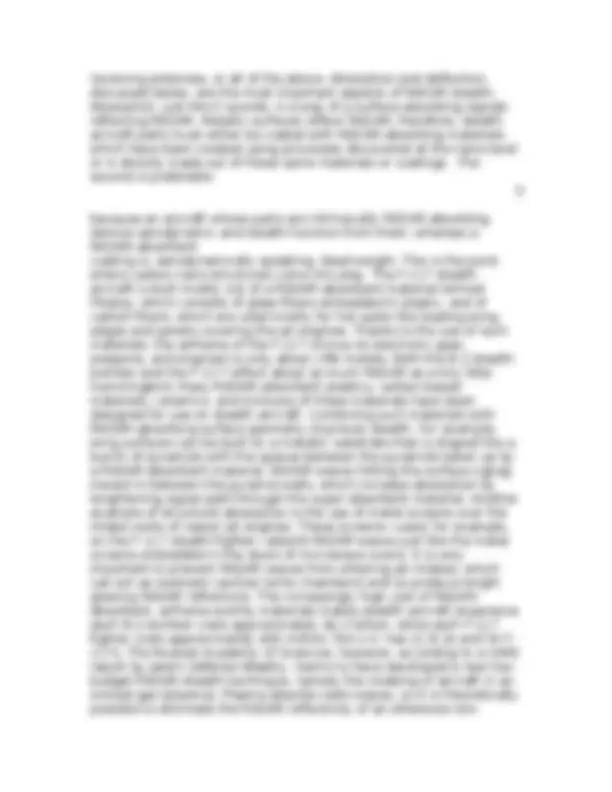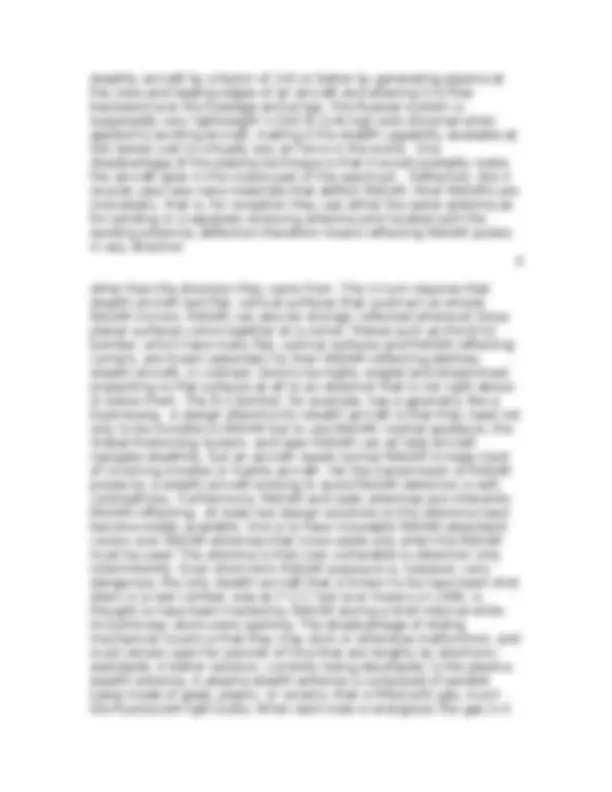





Study with the several resources on Docsity

Earn points by helping other students or get them with a premium plan


Prepare for your exams
Study with the several resources on Docsity

Earn points to download
Earn points by helping other students or get them with a premium plan
Community
Ask the community for help and clear up your study doubts
Discover the best universities in your country according to Docsity users
Free resources
Download our free guides on studying techniques, anxiety management strategies, and thesis advice from Docsity tutors
How nanotechnology research is revolutionizing military capabilities, focusing on stealth technology and advanced sensors. It discusses visual, infrared, acoustic, and radar stealth measures, as well as the importance of keeping aircraft parts cool and the use of materials like carbon nano-structures for radar absorption. The document also touches upon the development of bio-inclusive sensors and the potential of nanotechnology for internal vehicle repair.
Typology: Papers
1 / 6

This page cannot be seen from the preview
Don't miss anything!




One thing affecting the advancement of military capabilities in this day and age is the research within Nanotechnology. Defense programs in many countries are now concentrating on nanotechnology research that will facilitate advances in such technology used to create improved stealth capabilities for the militaries, aid in developing specialized sensors (including bio-inclusive sensors), which help to create self-repairing military equipment, and aiding in the development of smart weapons. In this paper I will discuss some of the recent advancements in these areas and make predictions on what is to come in the near future for our military and other countries militaries. The first topic I want to discuss is the improvement in stealth capabilities using nanotechnology. Design for stealth requires the integration of many techniques and materials. The types of stealth that an extremely stealthy aircraft (or other vehicle) seeks to achieve can be categorized as visual, infrared, acoustic, and RADAR. Low visibility is highly desirable for all military aircraft and is essential for stealth aircraft. It is accomplished by coloring the aircraft so that it tends to blend in with its environment. For instance, reconnaissance planes designed to fly at very high altitudes, where the sky is black, are painted black. (Black is a low visibility color at night, at any altitude.) Conventional daytime fighter aircraft are painted a tint of blue which is known as "air-superiority blue-gray," to camouflage in with the sky. Stealth aircraft are often flown at night for maximum visual stealth, and also are painted black or dark gray. Chameleon or "smart skin" technology that would allow an aircraft to change its appearance to mimic its background is being researched intensely in the nano-lab. Nanotechnology is playing a major role in this. New research is also being done on stealth uniforms, which also tend to blend with their environment like the skins of the aircraft, for our armed forces to assist in future upcoming wars. Infrared radiation particles (which use electromagnetic waves in the 72–1000 micron range of the spectrum) are emitted by all matter above absolute zero; hot materials, such as engine exhaust gases or wing surfaces heated by friction with the air, release more infrared radiation than cooler materials. Heat-seeking missiles and other weapons lock in on the infrared glow of hot aircraft parts. Infrared stealth, therefore, requires that aircraft parts and
emissions, particularly those associated with engines, be kept as cool as can be. Installing jet engines inside the fuselage or wings is one common design step toward infrared stealth. Other measures include; extra shielding of hot parts, mixing of cool air with hot 2 exhausts before emission; disjoining of the exhaust stream by passing it through parallel baffles so that it can mix with cooler air more quickly, directing of hot exhausts upward, away from ground observers, and the application of special coatings to hot spots to absorb and diffuse heat over larger areas which would be made possible by newer research on certain types of paint being tested in the nano-lab. Active countermeasures against infrared detection and tracking can be put together with passive stealth measures; these involve infrared jamming (which implies mounting of flickering infrared radiators near engine exhausts to confuse the tracking circuits by heat- seeking missiles) and the launching of infrared decoy flares. Combat helicopters, which travel at low altitudes and at low speeds, are highly vulnerable to heat-seeking weapons and have been equipped with newer infrared jamming devices for several decades and soon will be equipped with a new “smart skin” to blend with its surroundings. This will be accomplished using nanotechnology. Although sound moves too slowly to be an effective locating signal for anti-aircraft weaponry, for low-altitude flying it is still best to be inaudible to observers from the ground. Several ultra-quiet, low-altitude reconnaissance aircraft, such as Lockheed's QT-2 and YO-3A, have been designed since the 1960s. Aircraft of this type are ultra-light, run on small internal combustion engines silenced by silencer-suppressor mufflers, and are driven by huge, often wooden propellers. They make about the same amount of sound as gliders and have very low infrared emissions as well because of their extremely low energy consumption. The U.S. F-117 stealth fighter, which is designed to soar at high speed at very low altitudes, also incorporates acoustic-stealth measures, including sound- absorbent insulation inside its engine intake and exhaust cowlings. Carbon nanostructures help build these lightweight vehicles with all the strength of the older versions only these are much more advanced building techniques with amazing capabilities. RADAR is the use of reflected electromagnetic waves in the microwave part of the spectrum to detect targets or map landscapes. RADAR first lights up the target, that is, it transmits a radio pulse in its direction. If any of this energy is reflected by the target, some of it may be gathered by a receiving antenna. By comparing the delay times for various different echoes, information about the shape of the target can be derived and, if necessary, formed into a 3-D image. RADAR stealth or invisibility requires that a craft absorb incident RADAR pulses, actively cancel them by emitting inverse waveforms, deflect them away from
stealthy aircraft by a factor of 100 or better by generating plasma at the nose and leading edges of an aircraft and allowing it to flow backward over the fuselage and wings. The Russian system is supposedly very lightweight (>220 lb [100 kg]) and universal when applied to existing aircraft, making it the stealth capability available at the lowest cost to virtually any air force in the world. One disadvantage of the plasma technique is that it would probably make the aircraft glow in the visible part of the spectrum. Deflection, like it sounds uses new nano-materials that deflect RADAR_._ Most RADARs are monostatic, that is, for reception they use either the same antenna as for sending or a separate receiving antenna joint-located with the sending antenna; deflection therefore means reflecting RADAR pulses in any direction 4 other than the direction they came from. This in turn requires that stealth aircraft lack flat, vertical surfaces that could act as simple RADAR mirrors. RADAR can also be strongly reflected wherever three planar surfaces come together at a corner. Planes such as the B- bomber, which have many flat, vertical surfaces and RADAR-reflecting corners, are known adversely for their RADAR-reflecting abilities; stealth aircraft, in contrast, tend to be highly angled and streamlined, presenting no flat surfaces at all to an observer that is not right above or below them. The B-2 bomber, for example, has a geometry like a boomerang. A design dilemma for stealth aircraft is that they need not only to be invisible to RADAR but to use RADAR; inertial guidance, the Global Positioning System, and laser RADAR can all help aircraft navigate stealthily, but an aircraft needs normal RADAR to keep track of incoming missiles or hostile aircraft. Yet the transmission of RADAR pulses by a stealth aircraft wishing to avoid RADAR detection is self- contradictory. Furthermore, RADAR and radio antennas are inherently RADAR-reflecting. At least two design solutions to this dilemma have become widely available. One is to have moveable RADAR-absorbent covers over RADAR antennas that move aside only when the RADAR must be used. The antenna is then now vulnerable to detection only intermittently. Even short-term RADAR exposure is, however, very dangerous; the only stealth aircraft that is known to be have been shot down in a real combat, was an F-117 lost over Kosovo in 1999, is thought to have been tracked by RADAR during a brief interval while its bomb-bay doors were opening. The disadvantage of sliding mechanical covers is that they may stick or otherwise malfunction, and must remain open for periods of time that are lengthy by electronic standards. A better solution, currently being developed, is the plasma stealth antenna. A plasma stealth antenna is composed of parallel tubes made of glass, plastic, or ceramic that is filled with gas, much like fluorescent light bulbs. When each tube is energized, the gas in it
then becomes ionized, and it then can conduct current just like a standard metal wire. A number of these energized tubes in a flat, parallel array, wired for individual control (a "phased array"), are able to be used to send and receive RADAR signals from a wide range of angles without being physically rotated. When the tubes are not energized, they are invisible to RADAR, which can be absorbed by an appropriate backing. One advantage of such an array is that it can turn on and off very rapidly, and only act as a RADAR reflector during the electronically brief intervals when it is engaged. Nanotechnology brings new advancements in stealthing capabilities everyday and the more the research that is being done at the nano-level, the better off our armed forces will be in future wars and terror threats. The next topic is new specialized sensors or bio-inclusive sensors that can actually internally repair damages done to any vehicle during combat. The very small size of these sensors is what makes them so desirable. Using 5 nanotechnology we are able to create sensors so small they have to be seen by a high power microscope (nano-scope). These sensors are still in development and should be researched for quite some time extensively before they actually become a reality. Last but not least is the aiding in the development of smart weapons within the military. Smart weapons are the wave of the future and will play major roles in upcoming wars and defense capabilities of our own country. Nanotechnology allows us to design these new weapons at the nano-scale thus improving our technologies and improving our results from our testing of these devices. The more lightweight devices that help build these weapons improve the range and decreases the amount of chemical propellant needed to launch them, therefore, giving our country the advantage in just another aspect of the fight. My overall opinion is that Nanotechnology is playing a huge roll in the advancement of our military and its capabilities, thus allowing us to shine in many areas of research that other countries may not be so advanced in. This will give us the edge we may need in future battles to come where victory can be achieved without losing the lives of our good soldiers. Much research is still needed and electrical engineering students like my classmates and I may be the future of nanotechnology in itself. Classes like this help us gain interest in these cool new technologies so we can continue forward with our studies and soon master these new advances.